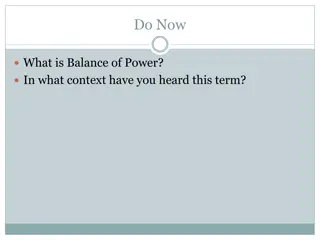
Working Time Regulations in Diplomatic Missions
"Explore the working time regulations for staff in diplomatic missions, including normal limits, specific times like on-call hours and travel time, work organization, and example schedules. Learn how these regulations protect workers' health and well-being in Belgium."
Download Presentation

Please find below an Image/Link to download the presentation.
The content on the website is provided AS IS for your information and personal use only. It may not be sold, licensed, or shared on other websites without obtaining consent from the author. If you encounter any issues during the download, it is possible that the publisher has removed the file from their server.
You are allowed to download the files provided on this website for personal or commercial use, subject to the condition that they are used lawfully. All files are the property of their respective owners.
The content on the website is provided AS IS for your information and personal use only. It may not be sold, licensed, or shared on other websites without obtaining consent from the author.
E N D
Presentation Transcript
Working time in diplomatic missions Jessica Bial - Advisor Directorate for Legal Support Vincianne Denuit - Manager contact center fr. October 2024 1
WORKING TIME Staff employed by diplomatic or foreign consular missions in Belgium who are not covered by the Vienna Conventions are subject to the provisions on working time of the Labour Law of 16 March 1971. Staff employed under a domestic work contract benefits from a special status, which shall not be covered in this presentation. 2
WORKING TIME Purpose: Purpose: Working time regulations are designed to protect the health and well-being of workers Concepts: Concepts: Working time: time during which the worker is at the employer's disposal (with some exceptions). Examples: Waiting time for a driver Time during which the worker receives training or work-related information. 3
WORKING TIME Specific times On On- -call time: call time: On-call at the workplace: regarded as working time. On-call at home: Only actual work is regarded as working time, with some exceptions. Travel time: Travel time: Travelling between 2 workplaces: regarded as working time 4
WORKING TIME Work Organisation: Work Organisation: The employer determines base work schedules and includes them in the work rules. Work rules must include details of working days and rest periods. 5
WORKING TIME Example of work schedule: Days Hours Hours Hours Hours Total hours to 5:30PM 8h Monday from M from M from M from M from M From 8:30A to M to 12:30P M to 12:30P M to 12:30P M to 12:30P M To 12:30P And from 1:30PM And from 1:30PM 8h Tuesday 8:30A To 5:30PM To 5:30PM 8h Wednesday 8:30A And from 1:30PM And from 1:30PM And from 1:30PM And from 8h Thursday 8:30A To 5:30PM 8h Friday 8:30A To 5:30PM To Saturday From To And from To Sunday Total: 40 h. 6
WORKING TIME Normal limits Principle: Principle: 8 hours a day maximum and 40 hours a week (or set lower limit) Since 2003 - working time brought down to 38 hours maximum Effective reduction: 38 hours a week Average reduction: 40 hours a week with compensatory time- off 7
WORKING TIME Normal limits Exceptions: Exceptions: Structural derogations week, ...) derogations (e.g: minor flexibility, English Occasional derogations voluntary overtime, ...) derogations (e.g: unforeseen necessity, 8
WORKING TIME structural derogations from normal limits Concepts: Concepts: Planned and structured overtime as part of the working time defined in the work rules Principle: Principle: No right to extra pay Right to recovery within the reference period (in principle 3 months) 9
WORKING TIME structural derogations from normal limits Example: Example: Minor Flexibility: Upward or downward alternative schedule Maximum 2 hours more or less per day, with a maximum of 9 hours per day Maximum of extra 5 hours or 5 hours less per week with a maximum of 45 hours per week Specific implementation and application procedures 10
WORKING TIME structural derogations from normal limits Example: upward schedule Days Hours Hours Hours Hours Total hours 9 To 6:30PM Monday from M from M from M from M from M From 8:30A To 12:30PM To 12:30PM To 12:30PM To 12:30PM To 12:30PM To And from 1:30PM And from 1:30PM And from 1:30PM And from 1:30PM And from 1:30PM And from To 6:30PM 9 Tuesday 8:30A To 6:30PM 9 Wednesday 8:30A To 6:30PM 9 Thursday 8:30A To 6:30PM 9 Friday 8:30A To Saturday From To And from To Sunday Total : 45 h. 11
WORKING TIME structural derogations from normal limits Example: downward schedule Days Hours Hours Hours Hours Total hours 7 To 4:30PM Monday from M from M from M from M from M From 8:30A To 12:30PM To 12:30PM To 12:30PM To 12:30PM To 12:30PM To And from 1:30PM And from 1:30PM And from 1:30PM And from 1:30PM And from 1:30PM And from To 4:30PM 7 Tuesday 8:30A To 4:30PM 7 Wednesday 8:30A To 4:30PM 7 Thursday 8:30A To 4:30PM 7 Friday 8:30A To Saturday From To And from To Sunday Total: 35 h. 12
WORKING TIME Occasional derogations from normal limits Concepts: Concepts: Exceeding outside regular working hours (unpredictable nature) Principle: Principle: Right to extra pay Right to recovery within the reference period (in principle 3 months) Possible exceptions (e.g. voluntary overtime) 13
WORKING TIME Occasional derogations from normal limits Examples: Unforeseen necessity: Conditions: unforeseeable event, additional and absolutely necessary services 11h/day maximum and 50h/week Extra pay and recovery (with exceptions) Procedures: notification to CLS/TSW Voluntary overtime : Conditions: prior written agreement with employer valid for 6 months Maximum: 11h/day and 50h/week Maximum per year: 120h Right to extra pay and payment for hours worked but no right to recovery 14
WORKING TIME May a worker refuse to work overtime ? Illegal overtime ? Legal overtime ? 15
WORKING TIME Recovery scheme At the end of the reference period (generally one quarter), the sum At the end of the reference period (generally one quarter), the sum of effective and assimilated work must be equal to the result of the of effective and assimilated work must be equal to the result of the following calculation: following calculation: Weekly working time Number of weeks in the reference period X Example: 38h Example: 13 weeks 16
WORKING TIME Recovery scheme Example: Example: Week Average working week : 38h Applied schedule Hours to be recovered 38 38 38 38 38 38 38 38 38 38 38 38 38 494 50 50 30 40 38 38 30 38 38 50 30 30 32 494 +12 +24 +16 +18 +18 +18 +10 +10 +10 +22 +14 +6 0 0 1 2 3 4 5 6 7 8 9 10 11 12 13 Total period reference 17
WORKING TIME RECOVERY SCHEME Assimilations Assimilations Public holidays Days on which performance of the employment contract is suspended under the law of 3 July 1978 (e.g. illness, annual holidays, etc.) 18 November 2017
WORKING TIME Recovery scheme Example: Example: Recovery to be granted: 48 hours worked or equivalent => 8 hours to be recovered 19
WORKING TIME Legal extra pay When must an extra pay be granted When must an extra pay be granted? ? more than 9h/day more than 40 hours/week or lower limit set (e.g. 38 hours) NB: only hours actually worked are taken into account 20
WORKING TIME Legal extra pay Example: Example: Extra pay to be paid: 40 hours were worked => no extra pay 21
WORKING TIME Legal extra pay Amount: Amount: 50% for overtime worked during the week 100% for overtime worked on a Sunday or a public holiday (or on a replacement day) Basis: Basis: Ordinary pay => night, Sunday, shift, danger, etc. bonuses are taken into account. 22
WORKING TIME Legal extra pay Exceptions: Exceptions: -structural exemptions (e.g. minor flexibility, etc.) - 23
WORKING TIME Legal extra pay Example: Example: Overtime to be paid: 40 hours have been worked => no weekly overtime, but there is a daily overtime of one hour from Monday to Thursday => 4 hours at 50%. 24
WORKING TIME Legal extra pay Example: Example: Overtime to be paid: 44 hours worked => weekly overtime of 4 hours and daily overtime of 1 hour on Tuesday and Friday => we take the most advantageous overtime for the worker: 4 hours at 50%. 25
WORKING TIME rest intervals During working time: During working time: Mandatory break during working hours after 6 uninterrupted hours of work (15' unless agreed by CLA or set by RD) Between two work periods: Between two work periods: - Between two working days of at least 11 hours - Once a week minimum of 11h + 24h for a total of 35h unless agreed otherwise 26
USEFUL INFORMATION For all general questions relating to working and pay conditions for diplomatic missions: Contact the Good Offices Commission : commissiondesbonsoffices@emploi.belgique.be 27




![Read⚡ebook✔[PDF] The Untold Stories of the Space Shuttle Program: Unfulfilled D](/thumb/21685/read-ebook-pdf-the-untold-stories-of-the-space-shuttle-program-unfulfilled-d.jpg)

















